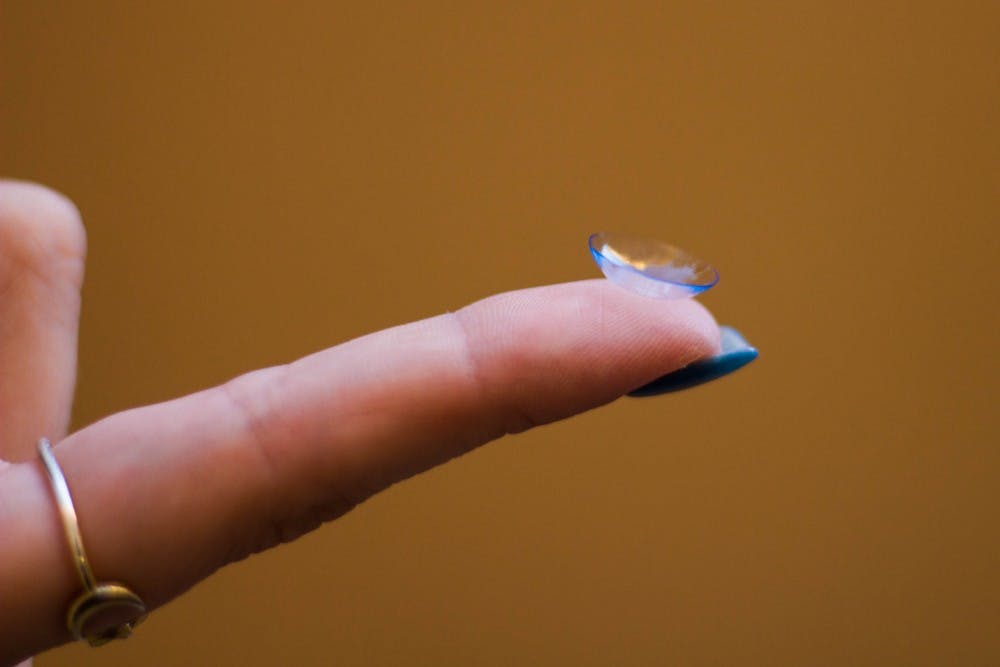Disposable contact lenses that are flushed down the drain instead of thrown in the trash pose a unique environmental risk, according to a new ASU study.
Charles Rolsky, a doctorate student in the College of Liberal Arts and Sciences, and Varun Kelkar, a graduate research assistant, studied the improper disposal of contact lenses and their potential environmental risk.
The team first assessed the scope of the problem by conducting an online survey.
“We got about 410 responses which told us that about 20 percent of contact users were flushing their contacts down some sort of drain,” Rolsky said. “So that told us that there’s a problem.”
Once they determined that the amount of improperly disposed contact lenses was significant, they started to conduct further research. Through a partnership with a local wastewater treatment plant, they were able carry out experiments on 11 different brands of disposable contact lenses, according to Rolsky.
“We specifically looked at what are called the aeration basins. Their job at the wastewater treatment plant is to have microorganisms break down solid material. There is an anaerobic and an aerobic basin, one with oxygen and one without," he said. "When they don’t add oxygen, it is so the microorganisms get really hungry and then they add oxygen and they go crazy and break everything down.”
Rolsky said the results were surprising – the lenses were resilient and had only slightly degraded. With this information, they went on to see if they could find the remnants of any disposable contact lenses in the biosolid, which is treated sludge that is prepared to leave a wastewater treatment plant at the end of the wastewater treatment process.
After a few hours of digging through just 10 pounds of biosolid, the team found what was later confirmed in their lab to be pieces of disposable contact lenses.
The contacts had fragmented into microplastics, which Kelkar said are any pieces of plastic less than five millimeters in diameter.
Rolsky said this is concerning because biosolids are taken to one of three places. They are either applied to land for agricultural purposes, taken to a landfill or taken to an incinerator and burned.
“(Microplastics) are dangerous to us because they are known to absorb contaminants in high concentrations," Rolsky said. "If there is a very small amount of pollution in the water, it will all attach to the plastics."
Rolsky said that because of the unique chemistry of contact lenses, classified as hydrogels, they are even more susceptible to pick up any pollutants in the wastewater treatment plant.
“If it is being delivered to agricultural areas, it could leech into the soil," Rolsky said. "Small organisms could start eating it and bring it up the food chain. If it is taken to a landfill, it will sit, but it will still interact with microorganisms. If it is incinerated, it is going to be burned, so anything in the plastic or attached to the plastic will go up into the atmosphere.”
According to Beth Polidoro, an assistant professor in the School of Mathematical and Natural Sciences, much of the impact of microplastics is still unknown but "we do know they are incredibly difficult to clean up."
Polidoro said she does not know of any technology that removes these microplastics from the environment.
"The chemicals in these microplastics can potentially pose a threat to human and environmental health," Polidoro said. "They can be found in the food that we eat and in our drinking water, but we don’t have a good understanding of our threshold for intake and the effects they can have on human health.”
However, new research, such as that of Rolsky and Kelkar, is ongoing.
“We are getting more informed every day on the possible impacts of microplastics, but we still have a long way to go," Polidoro said.
Reach the reporter at jmwillma@asu.edu or follow @JacobWillman3 on Twitter.
Like The State Press on Facebook and follow @statepress on Twitter.




